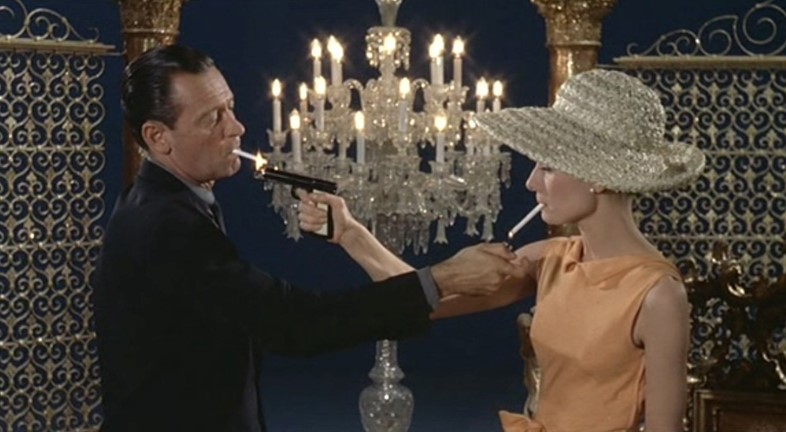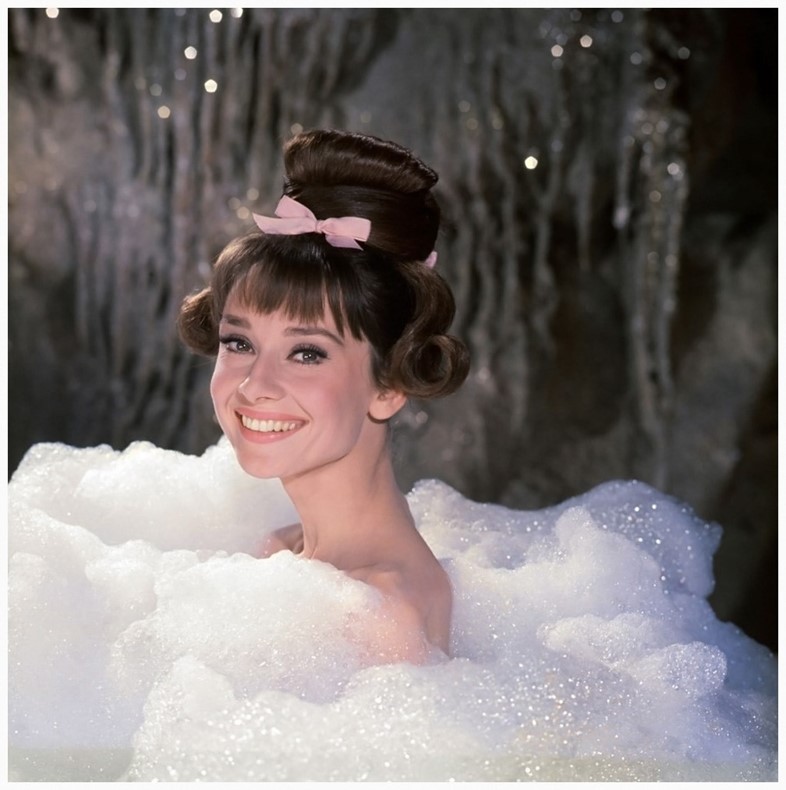Paris When It Sizzles is a meta look at the film industry in the 60s, starring Hepburn alongside William Holden in ensembles by Hubert de Givenchy
1964 film Paris When It Sizzles is a an irreverent take on the movie industry, made at a time when Hollywood was transitioning from its Golden Age to the more progressive decades of the 60s and 70s. Featuring a film-within-a-film and memorable amusing cameos from the likes of Noël Coward, Marlene Dietrich and Tony Curtis, the Richard Quine-directed movie tells the story of Richard Benson, a charismatic, procrastinating screenwriter played by William Holden, and Gabrielle Simpson, Benson’s charming temp secretary played by Audrey Hepburn. For a weekend in Paris, Benson and Simpson are in a hotel suite together creating a riotous script for The Girl Who Stole the Eiffel Tower, the film promised to Hollywood exec Alexander Myerheim (Coward) by Benson. Scenes from this fictitious film – in which Hepburn-as-Simpson is the eponymous girl, Gabby, embarking on an affair with Holden-as-Benson’s sometime-thief, -liar, -vampire and -cowboy, Rick – are spliced with the duo falling in love themselves, in conjunction with their corresponding characters.
Simpson is presented as a match in intellect for the “international wit” Benson, who is more bedraggled and aware of being middle aged (though Simpson assures him that he’s “remarkably well preserved”). She is vivacious and idiosyncratic, carrying a bird named Richelieu with her into the hotel, stating that she came to Paris “to live” – “Oh! Every morning when I wake up and I see there’s a whole new other day, I just go absolutely ape!” she exclaims – and viewing her circumstances with ever-growing enthusiasm through her “big, magic eyes”. The film also marked a decade of Hepburn’s creative relationship with Hubert de Givenchy, who had been designing her on-screen costumes and perfume since 1954’s Sabrina (in which Holden and Hepburn had also been co-stars; the duo famously had an affair during filming and he was reportedly still enamoured with her in 1964). As the anniversary of Paris When It Sizzles’ release approaches, we look at the intellectual and sartorial style of its leading lady.

The Signature Style
As Paris When It Sizzles is an ironic ode to the “good old-fashioned” films, hints at the direction cinema was taking in the 1960s are introduced through Simpson’s arrival in Benson’s hotel suite. Describing a script she had been typing up for a New Wave screenwriter, Simpson says “The picture is terribly interesting, very avant-garde. It’s about a lot of people who go to this party and decide not to play scrabble and then go home again. It’s called The Scrabble Game Will Not Take Place.” References to some of Hepburn’s previous roles are also alluded to – a prostitute “with a heart of gold” is no doubt Holly Golightly – and Simpson’s wild imagination plays out on screen as the duo conjure up spy movies, Westerns, thrillers and epic romances for the purposes of their unwritten script. The heroine’s intelligence is established early on, after an initial back-and-forth with Benson on the subtle differences between ‘implied’ and ‘inferred’ meaning.
Givenchy created dresses in powdery hues for Hepburn’s role, some with exaggerated, cinched detailing at the hips and others accessorised with more girl-ish bows and hats. For her alter-ego, the girl who stole the Eiffel Tower, Simpson wears an orange dress with a draped low back, collar and bow at the waist. While her outfits are generally structured, shift-y in shape – a green suit when she arrives, for example, and a white dress with a baby blue belt the following day – she also glides out from her room in a blue floating nightdress, its embroidered sleeves and train casting an intoxicating silhouette in Benson’s eyes. Her greatest and most unique accessory, however, is her bird Richelieu, whose lemon yellow covered cage she arrives with and who she leaves behind, forcing Benson to return it to her in the film’s final scene. Carrying Richelieu through Paris, the pair – Simpson in a bubblegum pink dress and matching bow in her hair, Benson in a sharp suit – gallivant through water fountains before embracing for “the earth-moving, studio rent-paying, theatre-filling, popcorn-selling kiss”.

The Modern Manifestation
The overtly meta nature of Paris When It Sizzles makes for intriguing and thought-provoking viewing, and its references to the state of Hollywood and stardom are both evocative of the era and relevant today. When Hepburn’s character is first introduced, the temptation is to assume she might end up secondary to Holden’s, but Simpson is as much the driving force behind the boisterous plot, recommending “switches” throughout in order to keep their audience guessing. Her pretty Givenchy-designed ensembles belie a sharp persistence and headstrong nature, which are exemplified when she orchestrates the final reunion with Benson by ‘forgetting’ Richelieu. Though Gabrielle Simpson is not Hepburn’s most cited role, it added another defiant, witty and resolute character to the star’s filmography.
